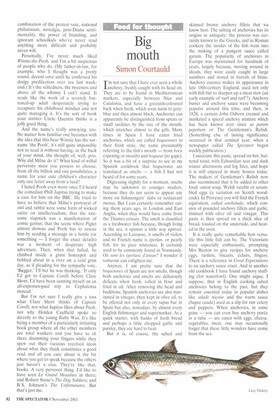Big mouth
Simon Courtauld
I'm not sure that I have ever seen a whole anchovy, freshly caught with its head on. They are to be found in Mediterranean markets, especially between Nice and Catalonia, and have a greenish-coloured back when fresh, which soon turns to greyblue and then almost black. Anchovies can apparently be distinguished from sprats or small sardines by the size of the mouth, which stretches almost to the gills. Many times in Spain I have eaten fried anchovies, which are called boquerones in their fresh state, the name presumably referring to the fish's mouth — from boca (opening or mouth) and boquear (to gape). So it was a bit of a surprise to see in my Spanish cookbook that boquerones are translated as smelts — a fish I had not heard of for some years.
Digressing slightly for a moment, smelts may be unknown to younger readers, because they do not seem to appear any more on fishmongers' slabs or restaurant menus. But I can certainly remember eating them years ago, in London and East Anglia, when they would have come from the Thames estuary. The smelt is classified as a freshwater fish because, though living in the sea, it spawns a little way upriver. According to Larousse, it smells of violets and its French name is Eperlan, or pearly fish, for its pure whiteness. It certainly used to be commonly found in Normandy. Oa sont les eperlans d'antan? I wonder if someone can enlighten me.
Anyway, I am pretty sure that the boquerones of Spain are not smelts, though both anchovies and smelts are deliciously delicate when fresh, rolled in flour and fried in oil. After removing the head and backbone, Spanish anchovies are also marinated in vinegar, then kept in olive oil, to be offered not only in every tapas bar in Spain but also, nowadays, by almost every English fishmonger and supermarket. As a quick starter, with hunks of fresh bread and perhaps a little chopped garlic and parsley, they are hard to beat.
But it is, of course, the salted and
skinned brown anchovy fillets that we know best. The salting of anchovies has its origins in antiquity: the process was certainly known to the Greeks, and in Roman cookery the insides of the fish went into the making of a pungent sauce called garum. The popularity of anchovies in Europe was maintained for hundreds of years, largely because, moving around in shoals, they were easily caught in large numbers and stored in barrels of brine. Anchovy essence makes its appearance in late 18th-century England, used not only with fish but to sharpen up a meat stew (an early example of 'surf and turf?). Anchovy butter and anchovy sauce were becoming popular around this time, and then, in 1828, a certain John Osborn created and marketed a spiced anchovy mixture which has been known ever since as patum peperium or The Gentleman's Relish. (Something else of lasting significance occurred in that seminal year, when a newspaper called The Spectator began weekly publication.) I associate this paste, spread on hot, buttered toast, with Edwardian teas and dark winter afternoons and log fires, and hope it is still enjoyed in many houses today. The makers of Gentleman's Relish now also recommend that it be added to other food: onion soup. Welsh rarebit or scrambled eggs (a variation on Scotch woodcock). In Provence you will find the French equivalent, called anchaade, which consists of pounded anchovy fillets and garlic, thinned with olive oil and vinegar. This paste is then spread on a thick slice of bread, toasted on the underside, and heated in the oven.
It is really quite remarkable how versatile this little fish can be. The Victorians were especially enthusiastic, prompting Mrs Beeton to give recipes for anchovy eggs, tartlets, biscuits, éclairs, fingers. There is a reference in Great Expectations to an anchovy sauce cruet. And in another old cookbook I have found anchovy stuffing (for waterfowl). One might argue, I suppose, that in English cooking salted anchovies belong to the past, but they remain essential today in popular dishes like salade nicoise and the warm sauce (bagna cauda) used as a dip for raw celery and peppers. When anchovies, in some guise — you can even buy anchovy purée in a tube — are eaten with eggs, cheese, vegetables, meat, one may occasionally forget that these little wonders have come from the sea.


































































































 Previous page
Previous page